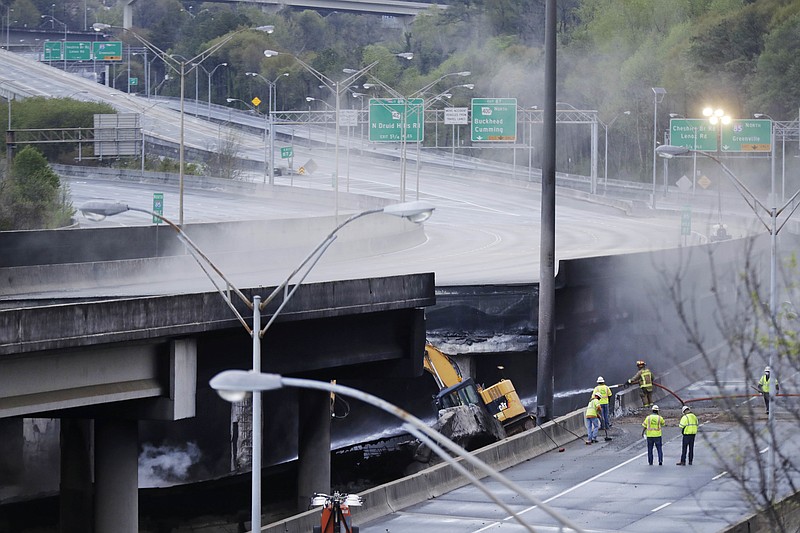ATLANTA - Minutes after I-85's spectacular collapse Thursday, a fellow named Carlos summed it up for us on Twitter: "So a big chunk of 85 just collapsed. God help us all."
It seems likely we'll need divine intervention, given that 250,000 cars traverse that key section of road each day. So where do a quarter-million cars and their seething drivers go when I-85 shuts down? On Atlanta's already clogged roads, that's where.

And those commuters will be scattered all over the grid for months as engineers and construction experts busy themselves with replacing the massive slab of concrete.
With that in mind, my inner pessimist was surprised to see the results of a traffic study conducted after the I-35W bridge over the Mississippi River collapsed in Minnesota in August 2007.
To be sure, there were great differences. The Minneapolis collapse killed 13 and injured 145. The Atlanta collapse appears to have hurt no one. Theirs was a tragedy. Ours is a headache.
There were similarities, though. Both cities lost key arteries and both had post- collapse predictions of a commuting Armageddon. After all, the Minneapolis bridge carried 140,000 vehicles per day.
So what did the study performed by civil engineers at the University of Minnesota find?
"Conclusion: Despite the heavy losses in life and injury, as well as the psychological shock, the collapse of I-35W bridge did not disastrously disrupt the overall traffic of Twin Cities network as initially predicted by the mass media. Travelers exhibited great flexibility in dealing with the changed traffic pattern."
First, let me say media types are alarmists by nature. And because the bridge collapse was so terrible, it only stood to reason that the fallout would be dreadful.
So, it is heartening that there is evidence saying commutes might not remain as absolutely crummy as they now seem.
I called Michael Hunter, a civil engineering prof at Georgia Tech who, among other things, specializes in traffic science and engineering.
"We'll see a change in underlying patterns and behavior - different routes, car sharing, different times," he said. "We'll see some underlying changes in traffic patterns with [drivers] trying to optimize their travel."
By optimizing, he means "minimizing their time." That is, time spent stewing behind the steering wheel, muttering terrible things about your fellow man.
"It will take a while for this to settle out," he said. "You'll find a new equilibrium."
Motorists, along with thousands of others, will try new routes. They'll get clogged, so they'll try another route. Rinse, repeat until they find something that works - or something less bad.
Let's return to the study to see how the Minnesotans reacted 10 years ago.
"Traffic patterns varied significantly immediately after the bridge collapse," the study said, until equilibrium occurred. It took almost three months.
Our professor said people might car pool. The Minnesota study concluded, "Nah."
Many here are predicting (or hoping, perhaps) that Atlanta's I-85 bridge collapse will bring a bump in MARTA ridership.
In Minneapolis? It largely stayed flat.
"Individuals resist changes in travel mode because it involves major shifts in lifestyle and is constrained by other factors such as service availability and car ownership," the study concluded.
The one thing that those studied did do was shift their commute schedule. More than a quarter of them left earlier for work, although just a handful - 4 percent - decided to leave later.
In all, commute times increased by a little less than 10 percent, which isn't bad, considering.
Randall Guensler, another civil engineering prof at Georgia Tech, said Atlanta might have more flexibility in its road and transit system than in Minneapolis or San Francisco, another place that suffered driving nightmares after the 1989 earthquake.
Granted, the Atlanta I-85 system lost eight northbound lanes (and a similar number of southbound lanes, for now), each lane designed to move 2,200 vehicles an hour when at peak efficiency. But Guensler is optimistic the city's system will absorb the 250,000 vehicles.
"I think it'll just be a little less convenient," he said, noting that massive events like the interstate fire and collapse are rare, so engineers don't have a lot of research to go by in determining how drivers react.
So, I guess for the next few months, you can say class is in.
Bill Torpy writes for The Atlanta Journal-Constitution.
New York Times News Service
